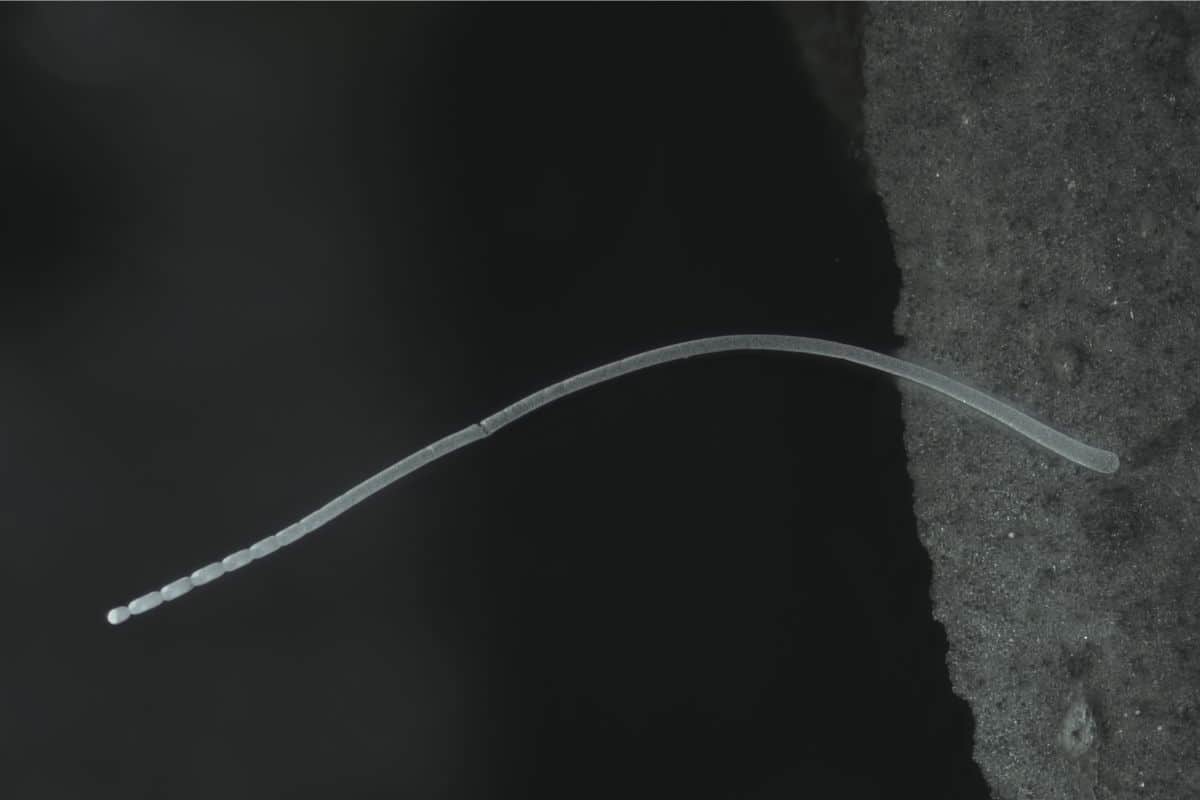

The bacterium is 5,000 times larger than most bacteria. “It’s like one person meeting another as tall as Mount Everest.”
Bacteria are generally very small. So small that they are only visible under a microscope. But researchers have now stumbled upon a very unusual specimen in a marine mangrove forest in Guadeloupe (a French overseas department in the Caribbean Sea). The newly discovered bacterium is immense; you can just see it with the naked eye.
Vermicelli-style threads
At first glance, the slightly cloudy water in the tube looks like nothing more than a little rainwater, mixed with leaves and light threads. But when the researchers took a closer look at the thin, vermicelli-like threads, they were surprised to discover that they are bacterial cells, visible to the naked eye. “The giant bacterium is 5,000 times larger than most bacteria,” said researcher Jean-Marie Volland. “To put that in context, it’s like a human meeting another the size of Mount Everest.”

Approx. Thiomargarita magnifica. Image: Jean-Marie Volland
macro-microbes
Further analysis reveals that the bacterium found in the marine mangrove is a sulfur-oxidizing prokaryote. A striking discovery. “At first I thought it was a eukaryote,” said study researcher Silvina Gonzalez-Rizzo. “I didn’t expect it to be bacteria because they are so big and have a lot of filaments. However, we soon realized that they were unique in that they consist of a single cell. The fact that these are ‘macro’ microbes is fascinating!”
What is the difference between prokaryotic and eukaryotic cells? The main difference lies in the nucleus: prokaryotes (organisms such as bacteria) do not have a nucleus, while eukaryotes (such as fungi, plants and animals) do have a nucleus. For a long time it was thought that life could be divided into these two domains. But in 1977, Carl Woese discovered that the prokaryotes consist of two separate groups: Bacteria and Archaea. Members of the latter group are mainly found in extreme conditions, such as hot springs. Since then, life has been divided into three domains: Bacteria, Archaea and Eukaryota.
The newly discovered bacterium is Approx. Thiomargarita magnifica named. That name can be traced back to the fact that the bacterium belongs to the genus Thiomargarita belongs. †Magnificent refers to magnuswhich in Latin means ‘great’ and at the same time on the French word ‘magnificent‘ seems,” says Gonzalez-Rizzo.
Size
The researchers decided to study the filamentous bacterium and its morphological and genomic features a little more closely. And that leads to some surprising discoveries. It turns out that the filaments can be as long as 9.66 mm. In addition, these indeed appear to be gigantic single cells and not multicellular filaments, as is common in other large sulfur bacteria.
DNA
But that’s not all. In most bacteria, the DNA floats freely in the cytoplasm of their cells. But the newly discovered bacterial species keeps its DNA better organized. “The big surprise of the project was when we realized that these genome copies that are distributed throughout the cell are actually in a structure that has a membrane,” explains Volland. “That is unusual for a bacterium.”
Pepinen
In addition, the team studied the filaments and cell membranes in more detail. This led to the discovery of new membrane-enclosed compartments containing DNA clusters. The researchers called these organelles “pepins,” referring to the tiny seeds in fruits. DNA clusters were abundant in the individual cells.
Genomic Complexity
The team learned more and more about the genomic complexity of Approx. Thiomargarita magnifica† “The bacteria contain three times more genes than most bacteria and hundreds of thousands of genome copies distributed throughout the cell,” Volland notes. With their study, the researchers show how special Approx. Thiomargarita magnifica in fact. It is a bacterium, but it is also very unique in many ways. “This project was a great opportunity to demonstrate how complexity evolved in some of the simplest organisms,” said study researcher Shailesh Date. “So organisms that we think are very, very simple may have some pretty big surprises in store for us.”
Although the researchers learned more about Approx. Thiomargarita magnifica learned, it has also led to new questions. One of these, for example, is the role of the bacterium in the mangrove ecosystem. In addition, the question arises whether the newly discovered organelles (the pepins) have been involved in the extreme size of the bacterium and/or whether pepins are present in other bacterial species. Successfully culturing the bacterium in the lab may answer some of these questions, the researchers conclude.
Source material:
†Giant bacteria found in Guadeloupe mangroves challenge traditional concepts– DOE Joint Genome Institute (via EurekAlert)
Image at the top of this article: Jean-Marie Volland